
Echinacea is a genus of herbaceous flowering plants in the daisy family. It has ten species, which are commonly called coneflowers. They are native only in eastern and central North America, where they grow in moist to dry prairies and open wooded areas. They have large, showy heads of composite flowers, blooming in summer. The generic name is derived from the Greek word ἐχῖνος, meaning "hedgehog", due to the spiny central disk. These flowering plants and their parts have different uses. Some species are cultivated in gardens for their showy flowers. Two of the species, E. tennesseensis and E. laevigata, were formerly listed in the United States as endangered species; E. tennesseensis has been delisted due to recovery and E. laevigata is now listed as threatened.
Tirania purpurea, the sole species in genus Tirania, is a species of climbing plant endemic to Vietnam. This genus is related to Forchhammeria and Stixis, but the placement of these three is uncertain. They were placed in Capparaceae until DNA studies showed them to be more closely related to Resedaceae that to Capparaceae. They are sometimes placed in their own family Stixaceae, but since it is not yet clear whether they are from a clade, they are better left in Brassicales unplaced at family rank.

Actaea, commonly called baneberry, bugbane and cohosh, is a genus of flowering plants of the family Ranunculaceae, native to subtropical, temperate and subarctic regions of Europe, Asia and North America.

Bauhinia × blakeana, commonly called the Hong Kong orchid tree, is a hybrid leguminous tree of the genus Bauhinia. It has large thick leaves and striking purplish red flowers. The fragrant, orchid-like flowers are usually 10 to 15 centimetres across, and bloom from early November to the end of March. Although now cultivated in many areas, it originated in Hong Kong in 1880 and apparently all of the cultivated trees derive from one cultivated at the Hong Kong Botanical Gardens and widely planted in Hong Kong starting in 1914. It is referred to as bauhinia in non-scientific literature though this is the name of the genus. It is sometimes called the Hong Kong orchid. In Hong Kong, it is most commonly referred to by its Chinese name of 洋紫荊 (yèuhng jígīng).

Digitalis purpurea, the foxglove or common foxglove, is a toxic species of flowering plant in the plantain family Plantaginaceae, native to and widespread throughout most of temperate Europe. It has also naturalized in parts of North America, as well as some other temperate regions. The plant is a popular garden subject, with many cultivars available. It is the original source of the heart medicine digoxin. This biennial plant grows as a rosette of leaves in the first year after sowing, before flowering and then dying in the second year. It generally produces enough seeds so that new plants will continue to grow in a garden setting.

Theobroma is a genus of flowering plants in the mallow family, Malvaceae, that is sometimes classified as a member of Sterculiaceae. It contains roughly 20 species of small understory trees native to the tropical forests of Central and South America.

Sarracenia purpurea, the purple pitcher plant, northern pitcher plant, turtle socks, or side-saddle flower, is a carnivorous plant in the family Sarraceniaceae.

Monardella is a genus of approximately 40 species of annual and perennial plants native to western North America from British Columbia to northwestern Mexico. They are grown for their highly aromatic foliage, which in some species is used for herbal teas. The two-lipped, tubular flowers are formed in terminal clusters and are most usually red, pink, or purple.
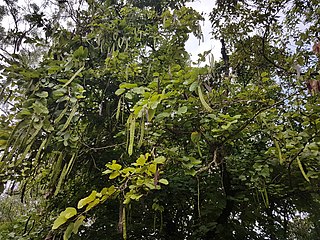
Bauhinia purpurea is a species of flowering plant in the family Fabaceae, native to the Indian subcontinent and Myanmar, and widely introduced elsewhere in tropical and subtropical areas of the world. Common names include orchid tree, purple bauhinia, camel's foot, butterfly tree, and Hawaiian orchid tree.

Echinacea purpurea, the eastern purple coneflower, purple coneflower, hedgehog coneflower, or echinacea, is a North American species of flowering plant in the family Asteraceae. It is native to parts of eastern North America and present to some extent in the wild in much of the eastern, southeastern and midwestern United States as well as in the Canadian Province of Ontario. It is most common in the Ozarks and in the Mississippi/Ohio Valley. Its habitats include dry open woods, prairies and barrens.
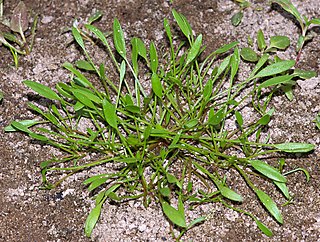
Limosella is a genus of flowering plants known as mudworts. These are annual, largely aquatic plants, found in muddy areas worldwide. Its phylogeny and biogeography are inferred from molecular data.

Nabalus is a genus of Asian and North American flowering plants in the tribe Cichorieae within the family Asteraceae.

Berkheya is a genus of flowering plants in the family Asteraceae. It is distributed in tropical Africa, especially in southern regions. Of about 75 species, 71 can be found in South Africa.

Lumnitzera is an Indo-West Pacific mangrove genus in the family Combretaceae. An English common name is black mangrove. Lumnitzera, named after the German botanist, Stephan Lumnitzer (1750-1806), occurs in mangroves from East Africa to the Western Pacific, and northern Australia.
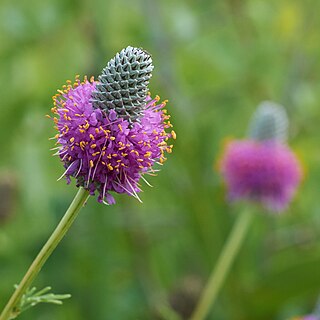
Dalea purpurea is a species of flowering plant in the legume family known as purple prairie clover. Native to central North America, purple prairie clover is a relatively common member of the Great Plains and prairie ecosystems. It blooms in the summer with dense spikes of bright purple flowers that attract many species of insects.

Phalonidia gilvicomana, the wall-lettuce conch, is a species of moth of the family Tortricidae. It is found in most of Europe. The habitat consists of woodlands, downlands and waste grounds.
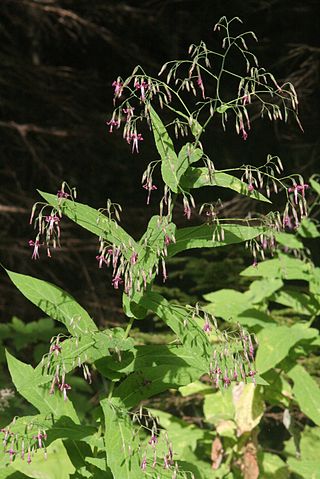
Prenanthes purpurea is a species of flowering plant in the family Asteraceae, native from Europe to northeastern Turkey and the Caucasus. It was first described by Carl Linnaeus in 1753. The species is sometimes called purple lettuce.

Piliostigma malabaricum is a small tree species in the family Fabaceae. It was previously placed in the genus Bauhinia, but names changed with reorganisation of the subfamily Cercidoideae and the tribe Bauhinieae.
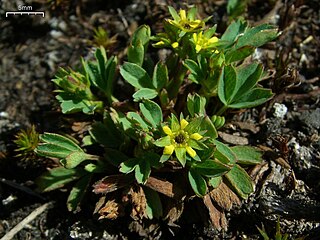
Sibbaldia is a genus of flowering plants of the family Rosaceae, with a circumpolar distribution, including the high Arctic. The type species is Sibbaldia procumbens. It is also in the Rosoideae subfamily.

Diapensia is a genus of flowering plants of the family Diapensiaceae. Most of the species are found in the Himalayas. Diapensia lapponica has a high Arctic, circumpolar distribution.



















